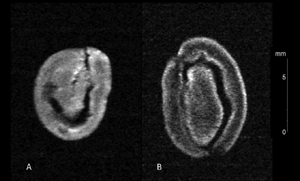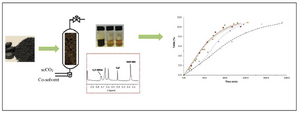User:SCGProject/Notebook/EBC 571/2021/09/01
From OpenWetWare
Jump to navigationJump to search
Brainstorming
SCG Samples
- Coffee from different countries, the same roasting profile.
- We should select the coffee that is from the same year (been being collected the same year)
- we will use only the SCG in the experiment but we will save the filtrate as well.
- Instead of buying +30 types of coffee, we can get only five but, we can repeat the experiment more than 3 times to work on Statistical analysis.
Techniques
- Gas chromatography (GC)
- High-performance liquid chromatography (HPLC)
- Isotoperatio mass spectrometry (IRMS)
- Ultraviolet−visible absorption spectroscopy (UV−vis)
- Elemental analysis-like inductively coupled plasma−atomic emission spectrometry (ICP-AES)
- Liquid chromatography−mass spectrometry (LC-MS)
Contact
- For Separation of the SCG: Dr. Raychelle Burks burks@american.edu
- For Characterization of the sample: Dr. Monika Konaklieva mkonak@american.edu
- For Food Chemistry Dr.Hartings hartings@american.edu
Abbreviations
- AOAC: Association of Official Analytical Chemists
- ComDim: Common Dimension)
- GC: Gas chromatography
- HPLC: High-performance liquid chromatography
- HTE: High temperature extraction
- IC: Instant cofee
- ICP-AES: Elemental analysis-like inductively coupled plasma−atomic emission spectrometry
- IRMS: Isotoperatio mass spectrometry
- LC-MS: Liquid chromatography−mass spectrometry
- LTE: Low temperature extraction
- NIR spectrometer: Near-IR (NIR) spectroscopy
- NMR: Nuclear Magnetic Resonance
- MTE: Medium temperature extraction
- RCBE: Roasted Coffee Bean Extract
- SCG : Spent Coffee Ground
- UV−vis: Ultraviolet−visible absorption spectroscopy
Articles
- 2011
- Media: 2011_Two-Dimensional_1H–13C_Nuclear_Magnetic_Resonance_(NMR)-Based_Comprehensive_Analysis_of_Roasted_Coffee_Bean_Extract.pdf
- Characterization by proton and carbon nuclear magnetic resonance (NMR) spectroscopy.
- A total of 24 coffee components, including 5 polysaccharide units, 3 stereoisomers of chlorogenic acids, and 2 stereoisomers of quinic acids, were identified with the NMR spectra of RCBE.
- NMR spectra tend to show complicated patterns because of signal overlaps and chemical-shift changes, resulting from the interactions among the various components, which creates a huge obstacle in NMR signal assignment.
- The experiments were performed using arabica coffee beans from Colombia
- A 50 g sample of the green beans was roasted in a home coffee roaster
- The roasted coffee beans were ground into grains about 1-2 mm in size
- 1.5 g of the crushed beans were incubated at 95 C in a closed plastic tube with 3.50 mL of 99.7% D2O for 1 h
- The pH value was checked
- Supernatant was introduced to a 5 mm NMR tube. A trace amount of 2,2-dimethyl-2-silapentane-5-sulfonic acid, sodium salt was used as an internal reference
- The extraction of coffee was performed in triplicate, and each extract of the triplicate was quantified.
- Statistical analysis was performed to confirm the reproducibility
- Characterization by proton and carbon nuclear magnetic resonance (NMR) spectroscopy.
- 2012
- Media:2012_13C_NMR-Based_Metabolomics_for_the_Classification_of_Green_Coffee_Beans_According_to_Variety_and_Origin.pdf
- By the application of information on 13C signal assignment, significantly different levels of 14 metabolites of green coffee beans were identified.
- 13C NMR spectroscopy with detailed assignment information, coupled with PCA and OPLS-DA models, was applied to distinguish the species and origins of green coffee beans and to identify significantly different metabolites between species and origins
- We used Arabica coffee beans from four origins (Brazil, Colombia, Guatemala, and Tanzania) and robusta coffee beans from two origins (Indonesia and Vietnam)
- The green coffee beans were frozen at −30 °C until analyzed.
- The green coffee beans were ground into grains about 1−2 mm in size
- The crushed beans (1.5 g) were incubated at 95°C in a closed plastic tube with D2O for 1 h
- The extracts were cooled on ice for 15 min and then centrifuged at 5000g at 4 °C for 5 min.
- The supernatant (500μL) was removed to a new tube and mixed with phosphate buffer (100 μL, 0.2 M sodium phosphate, pH 6.0)
- 4,4-Dimethyl-4-silapentane-1-sulfonate was used as the internal reference, and its chemical shift was set to 0 ppm
- The green coffee bean extracts (GCBE) were then transferred into 5 mm NMR tubes.25
- 2014
- Media:2014_A_pilot_study_of_NMR-based_sensory_prediction_of_roasted_coffee_bean_extracts.pdf
- The chemical substances in roasted coffee bean extracts that could distinguish and predict the different sensations of coffee taste were identified by the combination of NMR-based metabolomics and human sensory test and the application of the multivariate projection method of orthogonal projection to latent structures (OPLS).
- The tastes of commercial coffee beans were successfully predicted based on their NMR metabolite profiles using our OPLS model
- The purpose of the present study was to develop a novel method to predict the tastes of coffee using NMR-based metabolomics.
- Green coffee beans of the arabica type from Brazil and Colombia and of the robusta type from Indonesia
- Different roasting level
- All roasted coffee beans were sealed under a vacuum and stored at 20 C until use
- For NMR spectroscopic observations, the crushed beans (1.5 g) were incubated at 95 C in a closed plastic tube with D2O for 1 h
- The extracts were cooled on ice for 15 min and then centrifuged at 5000g at 4 C for 5 min.
- The supernatants (500 ll) were moved to new tubes, and a trace amount of 4,4-dimethyl-4-silapentane-1-sulphonate was added as an internal reference, with a chemical shift set to 0 ppm. The coffee bean extracts were then transferred into 5 mm NMR tubes.
- 2015
- Media:2015_Assessment_of_green_coffee_bean_metabolites_dependent_on_coffee_quality_using_a_1H_NMR-based_metabolomics_approach.pdf
- Identification of green coffee bean metabolites related to coffee bean quality using a 1H NMR-based metabolomic analysis of well-established specialty-grade green coffee beans, in particular, of a single species (Coffea arabica).
- The higher levels of sucrose and the lower levels of γ-aminobutyric acid (GABA), quinic acid, choline, acetic acid and fatty acids observed in specialty or high-grade green coffee beans, compared to commercial-grade beans, were suggestive to be multiple markers for characterizing specialty green coffee bean.
- Variety of analytical techniques:
- Near-infrared spectroscopy (NIRS)
- Gas chromatography (GC)
- High-performance liquid chromatography (HPLC)
- Liquid chromatography-mass spectrometry (LC-MS)
- Inductively coupled plasma atomic emission spectroscopy (ICP-AES)
- Visible micro-Raman spectroscopy
- Ten grams of the green coffee beans were ground into grains less than 1 mm in size
- Freeze-dried for 48 h and then stored at −80 °C until extraction.
- Twenty milligrams of freeze-dried sample was dissolved in a mixture of methanol-d4 and sodium phosphate buffer in a 1.5 mL Eppendorf tube.
- The mixture was sonicated for 30 min at 25 °C to extract metabolites then centrifuged at 13000 rpm for 15 min at 10 °C.
- Media:2015_Structural_elucidation_of_tannins_of_spent_coffee_grounds_by_CP-MAS_13C_NMR_and_MALDI-TOF_MS_.pdf
- Characterize the composition, constituent monomer, and oligomeric structure of tannins of spent coffee grounds (SCG).
- Tannins of SCG are primarily composed of catechin, gallocatechin, chebulic acid, gallocatechin-3-O-gallate and accompanied by minor amount of fisetinidin concurrently
- Tannins are water-soluble naturally occurring complex polyphenolic compounds
- Tannins of SCG hold immense potential to compete with the conventional synthetic phenolic materials since it is an inexpensive and renewable natural resource that is available in abundance across the world.
- Techniques
- CP-MAS
- 13C NMR
- MALDI-TOF mass spectrometry
- Tannins of SCG (C. liberica) were extracted by using 5% sodium hydroxide solution at 100 ◦C for 30 min. 50% acetonitrile in 0.1% trifluoroacetic acid and -cyano-4-hydroxycinnamic acid for the analysis works
- 2016
- Media:2016_Classification_of_Coffee_Beans_by_GC-C-IRMS,_GC-MS,_and_1_H-NMR.pdf
- Discrimination of coffees from Colombia versus nearby countries (Brazil and Peru)
- Techniques
- Near-Infrared Spectroscopy (NIRS)
- Mass Spectrometry (MS)
- Nuclear Magnetic Resonance (NMR)
- 34 samples of roasted coffees (Coffea arabica L.) were collected over a two-year period, 2012 to 2013, from 3 different countries of South America
- 15 samples from Colombia, 11 from Brazil, and 8 from Peru.
- Media:2016_Coffee-_Health_Effects_.pdf
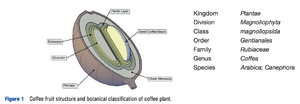
Figure 1 Coffee fruit structure and botanical classification of the coffee plant. - Generally, 240 ml of instant coffee contains approximately 100 mg of caffeine. Caffeine content can be, however, influenced by the different technologies used.
- For instance, green bean dewaxing and wet processing can reduce its content, which remains in the range of 0.65–2.30%.
- Coffee is a complex array of biologically active components that can influence many metabolic processes.
- The main components are alkaloids (caffeine and trigonelline), phenolic compounds (chlorogenic acids), and diterpenes (cafestol and kahweol)
- 2017
- Media:2017_Authenticity_of_roasted_coffee_using1H_NMR_spectroscopy.pdf
- The conventional methods that are most widely used in laboratories to identify the adulteration of roasted and ground coffee involve the use of optical and electron microscopy
- nuclear magnetic resonance spectrometry (NMR) coupled with multivariate statistics has been shown to be a useful procedure for the determination of adulterants in different food matrices
- Nineteen batches of coffee beans were harvested at different farms in Brazil located in Guaxupé (south of Minas Gerais state), Franca (north of São Paulo state), and Paraná state.
- The samples used were a set of commercial Brazilian arabica blends produced from good cup quality beans, classified as ‘strictly soft’ and ‘soft’, and four adulterants (corn, coffee husks, barley, and soybean) purchased locally.
- The samples were roasted in a spouted bed roaster (IRoast, Gurnee, IL), using a temperature program from 196 �C (3 min) to 235 �C (2 min), resulting in a light-medium roast, according to the Roast Color Classification System (AGTRON— SCAA, USA, 1995).
- In order to ensure reliability of the results, 24 commercial coffee blends from different regions of Brazil were analyzed
- Portions (150 mg) of the roasted and ground materials (coffee, corn, coffee husks, barley, and soybean) were weighed into 2-mL Eppendorf tubes, followed by addition of 1000mL of deuterated water.
- The tubes were vortexed for 1 min at room temperature and centrifuged at 87,965 rad/min (14000 rpm) for 10 min (Universal model 320R).
- Subsequently, 750-mL aliquots of supernatant were collected with an automatic volumetric pipette and transferred to 5-mm NMR tubes for analysis.
- The extractions were performed in triplicate.
- A data matrix was constructed by integration of the 1H NMR data signals. Subsequently the data were treated and submitted to exploratory analysis using unsupervised pattern recognition, employing principal component analysis (PCA).
- The statistical analyses were performed with Pirouette v. 4.0 software.
- Media:2017_Chemometric_Analysis_of_1H_NMR_Fingerprints_of_Coffea_arabica_Green_Bean_Extracts_Cultivated_under_Different_Planting_Densities_.pdf
- The use of 1H NMR data associated with chemometric techniques allows the determination of metabolic fingerprints and verification of metabolic changes when coffee is subjected to high planting densities.
- The aim of this work is to investigate 1H NMR spectral data of green bean extracts of Coffea arabica cv. IAPAR 59 grown in a square pattern at two planting densities, 6000 and 10,000 plants ha−1
- Thirty extracts were obtained using a simplex centroid design with four solvents (ethanol, acetone, dichloromethane, and hexane).
- The lyophilized extracts were dissolved in DMSO-d6 to obtain the 1H NMR spectra.
- The spectral data were analyzed with principal component (PCA) and cluster analyses (CA).
- Significant differences between ethanolic and non-ethanolic extracts were found by PCA.
- Only the ethanolic mean spectrum showed characteristic chemical shifts of sugars and trigonelline.
- Acetone extracts were separated by cluster analysis.
- The simplex centroid design for four components was used for obtaining the extracts of each treatments according Delaroza et al. (2014).
- Ethanol, acetone, dichloromethane, hexane, and their binary, ternary, and quaternary mixtures were investigated
- For the NMR analysis, 0.0300 g of each extract was dissolved in 0.5 mL of DMSO-d6.
- The Excel software was used for building the data matrix of 1H NMR spectra
- Media:2017_Introducing_Undergraduate_Students_to_Metabolomics_Using_a_NMRBased_Analysis_of_Coffee_Beans.pdf
- The students characterize the water-extractable organic components in these samples using 1H NMR spectroscopy, and then analyze the population of 1H NMR spectra using principal component analysis13,14 (PCA) to distinguish the subpopulations representing the arabica and robusta varieties
- 2018
- Media:2018_NMR-driven_identification_of_anti-amyloidogenic_compounds_in_green_and_roasted_coffee_extracts.pdf
- Our data showed that green and roasted coffee extracts and their main components, 5-O-caffeoylquinic acid and melanoidins, can hinder Aβ on-pathway aggregation and toxicity in a human neuroblastoma SH-SY5Y cell line.
- Coffee extracts and melanoidins also counteract hydrogen peroxide- and rotenone-induced cytotoxicity and modulate some autophagic pathways in the same cell line.
- Coffee extracts were obtained using a hydroalcoholic extraction procedure.
- Briefly, 200 mg of ground sample was extracted with 20 mL of a mixture of acidified (with 0.1 M HCl) water (pH 4.5; 70%) and methanol (30%) by sonication at 30 kHz for 15 min in an ultrasound bath (Elmasonic P 30H, Elma Schmidbauer GmbH, Singen, Germany) at 30 °C.
- After 1 h, the solutions were filtered through cotton wool and 0.45 µm PTFE filters (Pall Corporation, Port Washington, NY, USA), concentrated under reduced pressure at 40 °C and freeze-dried.
- The lyophilized samples were stored at −20 °C.
- Media:2018_Organic_and_conventional_coffee_differentiation_by_NMR_spectroscopy.pdf
- The present study reports the application of 1H NMR profiling for the differentiation of organic and conventional Coffea arabica roasted coffee samples.
- NMR data of coffees with different geographical origins have been analyzed by chemometrics for a possible metabolite differentiation.
- Multivariate statistical analysis was performed by using SIMCA-P 13.03 software (Soft Independent Modeling of Class Analogy
- A total of 68 samples of roasted and ground C. arabica coffee of different geographical origin and production periods have been recruited in Italy from local markets or directly provided by producers.
- Among them, 42 were conventional and 26 were organic roasted coffee
- Quinic acid is one of the most bitter tasting components in roasted coffee and its larger content in in organic coffee is most likely due to chlorogenic acids decomposition.
- Water soluble polysaccharides are considered responsible for the “body” of coffee, which gave the creamy effect.
- These compounds, typically present in the insoluble form of cellulose or glycoprotein in green coffee beans, are produced during the roasting process due to heating degradation, and they resulted characterizing the organic roasted coffee.
- Media:2018_GREEN_EXTRACTION_OF_HIGH_ADDED_VALUE_SUBSTANCES_FROM_SPENT_COFFEE_GROUNDS-_PRELIMINARY_RESULTS.pdf
- A supercritical fluid extraction (SFE) with pure CO2 and ethanol as a co-solvent (10 %) of spent coffee grounds was carried out at temperatures from 313 K to 333 K, pressures up to 40.0 MPa and the results obtained were compared with those of the conventional Soxhlet method using n-hexane as a solvent.
- The SCGs from an espresso machine were acquired from a local coffee shop, then dried at 105oC and stored in a refrigerator at 4o C until used.
- The organic extraction method applied in our study was a conventional solid/liquid extraction with a Soxhlet extractor.
- 25 g of coffee samples were extracted with 250 mL of n-hexane for 4 h at the solvent boiling point.
- The result solution (solvent+oil) was filtered and dried over anhydrous sodium sulfate.
- The solvent was subsequently evaporated from the extracted oil in a rotary evaporator (Büchi, model R-205).
- The global yield was calculated as the mean value from duplicate experiments taking into consideration the ratio between the extract mass and that of the raw material.
- Media:2018_Influence_of_solvent_selection_and_extraction_temperature_on_yield_and_composition_of_lipids_extracted_from_spent_coffee_grounds_.pdf
- Spent coffee grounds (SCG) are a potentially sustainable source of C16-C18 triglycerides. This study investigates known solvent extraction technologies with a wide range of solvents for lipid extraction from SCGs, and determines the effect of solvent selection and process temperature on the extraction efficiency and composition of the obtained oil.
- Spent coffee grounds (SCG) are the residues obtained during coffee brewing and represent the main coffee industry residual material
- Coffee seeds contain lipids stored in the endosperm tissue as energy reserve for germination and post-germination growth
- Coffee oil is mainly comprised of triglycerides and small amounts of diglycerides, monoglycerides and FFAs with the glyceride portion accounting for 80–95%, while the rest of the oil consists of terpenes, sterols and tocopherols
- Previous studies that investigated the extraction of lipids from SCGs through the Soxhlet method reported oil yields ranging from 7 to 30.4% w/w on a dry weight basis, with most researchers reporting values between 11 and 20% w/w
- Other researchers have used solvent extraction variations for extraction of SCG oil including microwave-assisted extraction with extraction ratios reported to range between 77.25 and 82.63% w/w of the total available oil
- ultrasound assisted extraction with extraction ratios of 83–98% w/w of the total available oil
- The samples were dried prior to oil extraction at a temperature of 100 °C for 5.5 h.
- 2019
- Media:2019_Coffee_variety,_origin_and_extraction_procedure-_Implications_for_coffee_beneficial_effects_on_human_health.pdf
- Media:2019_Comparison_and_quantification_of_chlorogenic_acids_for_differentiation_of_green_Robusta_and_Arabica_coffee_beans.pdf
- Media:2019_Dark_coffee_consumption_protects_human_blood_cells_from_spontaneous_DNA_damage.pdf
- Media:2019_Evaluating_the_effect_of_roasting_on_coffee_lipids_using_a_hybrid_targeted-untargeted_NMR_approach_in_combination_with_MRI.pdf
- Media:2019_Extraction_of_polyphenols_and_synthesis_of_new_activated_carbon_from_spent_cofee_grounds.pdf
- Media:2019_NMR_analysis_of_roasted_coffee_lipids_and_development_of_a_spent_ground_coffee_application_for_the_production_of_bioplastic_precursors_.pdf
- 2020
- Media:2020_Effect_of_roasting_degree_of_coffee_beans_on_sensory_evaluation-_Research_from_the_perspective_of_major_chemical_ingredients.pdf
- The objective of the present study was to clarify the physical morphology changes, main chemical ingredients, and cupping scores of arabica coffee beans of different roasting degrees, by scanning electron microscopy (SEM), nuclear magnetic resonance (NMR), and sensory analysis, respectively
- Once green beans are roasted, intricate physical and chemical changes occur. Physical changes are mainly reflected in the dramatic changes in the shape, water content, density, color, and internal structure of beans
- For SEM characterization, three green beans, MRBs, and DRBs with uniform shape was selected, respectively
- Detection of major chemical constituents by 1H NMR
- Extraction solvent screening
- 1H NMR signal acquisition
- The change in microstructure caused by roasting has major influence on the final quality of coffee beverage.
- During roasting, the green beans are heated at 200–240 °C for 10–15 min. External temperature, roasting time, coffee bean size, shape, water content and other factors will affect the change of coffee microstructure and the occurrence of chemical reactions, thus affecting the generation and release of flavor substances
- Exploring changes in the main chemical ingredients based on 1H NMR
- Roasting degree marker mining basing on multivariate analysis
- The changes in microstructure and main chemical ingredients during the roasting of coffee beans were clarified by SEM and 1H NMR,respectively. 1H NMR combined with multivariate analysis was confirmed to be an effective strategy to monitor the roasting degree
- Trigonelline, sugars, malate, quinic acids, γ-butyro-lactone and acetate showed potential to be used to monitor the roasting degree of coffee beans
- Multivariate analysis and correlation analysis proved that the content of coffee's main ingredients did have significant effects on acidity and body, especially the effect on body. The PLS model based on the main chemical components was used in an exploratory manner for prediction of body score and demonstrated good prediction performance
- Media:2020_Fully_Automated_Identification_of_Coffee_Species_and_Simultaneous_Quantification_of_Furfuryl_Alcohol_Using_NMR_Spectroscopy.pdf
- Objective: The aim of this study was to identify coffee species and other properties using nuclear magnetic resonance (NMR) spectroscopy, specifically to conduct quantification of the roasting process contaminant furfuryl alcohol
- Method: The quantification of furfuryl alcohol was performed from the NMR spectra using the pulse length-based concentration (PULCON) methodology. Prior to NMR analysis, samples were extracted using deuterated chloroform
- Results: Roasting experiments identified the maximum roasting temperature to be the most significant factor in the formation of furfuryl alcohol. Among the coffee species, C. canephora was found to contain a relatively lower amount of furfuryl alcohol compared to C. arabica. The roasting of wet processed coffee resulted in higher contents of furfuryl alcohol
- Conclusion: Validation results show that NMR spectroscopy is fit-for-purpose to obtain targeted information of coffee samples
- Media:2020_Quantitative_NMR_Methodology_for_the_Authentication_of_Roasted_Coffee_and_Prediction_of_Blends_.pdf
- a fit-for-purpose quantitative 1H NMR methodology was developed to authenticate pure coffee (100% arabica or robusta) as well as predict the percentage of robusta in blends through the study of 292 roasted coffee samples in triplicat
- As a result, the proposed methodology provides a systematic methodology and a linear regression model to support the classification of known and unknown roasted coffees and their blends
- characterize the chemical composition of coffee using high-performance liquid chromatography (HPLC),4 gas chromatography (GC),12,13 NMR,14−17 near-infrared (NIR),18,19 and infrared (IR) spectroscopy
- Media:2020_The_main_effects_of_elevated_CO2_and_soil-water_deficiency_on_1H_NMR-based_metabolic_fingerprints_of_Coffea_arabica_beans_by_factorial_and_mixture_design.pdf
- In this work, Coffea arabica trees were grown in a FreeAir Carbon Dioxide Enrichment dispositive under factorial design (22) conditions considering two CO2 levels and two soil-water availabilities. The 1 H NMR mixture design fingerprinting effects of CO2 and soil-water levels on beans were strategically investigated using the principal component analysis (PCA), analysis of variance (ANOVA) - simultaneous component analysis (ASCA) and partial least squares-discriminant analysis (PLS-DA)
- Media:2020_Biosynthesis_of_silver_nanoparticles_as_catalyst_by_spent_coffee_ground-recycled_poly(ethylene_terephthalate)_composites.pdf
- Media:2020_Magnetic_spent_coffee_ground_as_an_efficient_and_green_catalyst_for_aerobic_oxidation_of_alcohols_and_tandem_oxidative_Groebke–Blackburn–Bienaymé_reaction.pdf
- Media:2020_Supercritical_CO2_extraction_of_spent_coffee_grounds._Influence_of_co-solvents_and_characterization_of_the_extracts.pdf
- 2021
- Media:2021_Advanced_instrumental_characterization_of_the_coffee_extracts_produced_by_pilot_scale_instant_coffee_process_.pdf
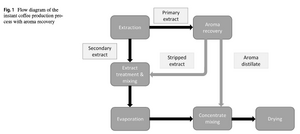
Fig. 1 Flow diagram of the instant coffee production process with aroma recovery - In this work, we present how the combination of 1H NMR and GC–MS allows the characterization of samples from the small pilot-scale instant cofee process.
- Results were compared with measurements for filter coffee made from the same coffee beans to better evaluate the effects of processing.
- In the coffee extracted at lower temperatures, a higher concentration of aroma compounds can be detected. This is particularly the case for compounds responsible for earthy (pyrazines) and woody (guaiacols) aroma notes.
- For the coffee extracted at the highest temperature, a higher level of cyclotene giving undesired burnt and bready aroma is seen.
- The caffeine content in instant coffees was lower than in the filter coffee (49±13 up to 62±5 mg/100 mL brew for instant compared with 84±15 mg/100 mL brew for filter coffee).
- The same was observed for acetic acid, while the concentrations of citric and quinic acids are lower in the filter coffee than in the reconstituted instant coffee.
- For instant coffee 1.5 g powder was dissolved in 100 g deionized water at 95 °C.
- For filter coffee 5.0 g of ground coffee (the same grind as used for the pilot-scale extraction) was transferred to a Whatman grade 2 paper filter (GE Healthcare, Chicago, USA) and extracted with 100 g deionized water at 95 °C.
- Samples for GC–MS were stored frozen until the analysis was performed
- Dry matter was determined gravimetrically after drying approximately 20 g of the sample at 80 °C for 16 h
- Media:2021_Chemical_ingredients_characterization_basing_on_1_H_NMR_and_SHS-GC-MS_in_twelve_cultivars_of_Coffea_arabica_roasted_beans_.pdf
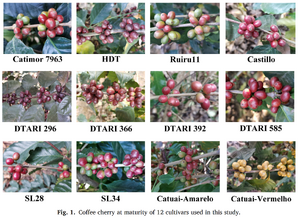
Fig. 1. Coffee cherry at maturity of 12 cultivars used in this study. - This work aimed to study the composition differences of roasted beans between 12 coffee cultivars (Catimor 7963, HIBRIDO DE TIMOR, Ruiru 11, Castillo, DTARI 296, DTARI 366, DTARI 392, DTARI 585, SL28, SL34, Catuai-Amarelo and Catuai-Vermelho) from Bourbon-Typica group and Introgressed group under subtropical humid monsoon climate
- The water-soluble compounds of roasted coffee beans were characterized by proton nuclear magnetic resonance spectroscopy (1 H NMR)
- The aroma components were analyzed by static headspace gas chromatography-mass spectrometry (SHS-GC/MS).
- 20 water-soluble compounds and 43 volatile compounds were identified.
- Compounds were identified based on their retention indices (RI) and mass spectra.
- RI of each compound was calculated by injecting n-alkanes mixtures (C8-C40) under the same conditions, which were compared with data from the literature.
- The mass spectra were compared with those from the NIST database.
- Media:2021_Integrated_1H_NMR_fingerprint_with_NIR_spectroscopy,_sensory_properties,_and_quality_parameters_in_a_multi-block_data_analysis_using_ComDim_to_evaluate_coffee_blends_Author_links_open_overlay_panel.pdf
- The chemical composition of coffee dictates its flavor and aroma, meaning its cup profile, and consequently its price during trading and export
- However, to date, no study has been carried out to characterize the quality and composition of coffee blends with different cup and roasting profiles, a subject that deserves attention.
- 1H NMR and NIR spectroscopy are complementary techniques, where 1H NMR provides metabolite fingerprints and complements the molecular information obtained with NIR spectroscopy.
- The coffee cherries were from the 2016/2017 and 2017/2018 crops and were obtained by dry process.
- The green beans were mechanically dried (CIA Lilla, Brazil) to a moisture content of 12% and dehusked using a coffee hulling machine (CIA Lilla, Brazil).
- The samples of green Arabica coffee were previously classified by the cup as hard, rioysh, and rio, while Robusta was classified as excellent.
- A total of forty-eight genuine samples (0.5 kg per sample) were collected and considered in this study, representing the industrial process where tons of coffee were being produced. From these:
- fifteen samples were collected for coffee blend 1
- fifteen were from coffee blend 2
- fifteen were from coffee blend 3
- From coffee blend 4, which is a superior coffee, three samples were collected due to the lowest production in the sector.
- Four quality parameters (granulometry, color, infusion time, and moisture content) were evaluated in all coffee blend samples (n = 48) as is usually done in the industry, using methods described previously in the literature for the same samples
- Granulometry was measured using 100 g of each sample on a vibrating platform (Bertel, Caieiras, Brazil) for 10 min and 2 mm in amplitude.
- Color measurement was performed on a Minolta colorimeter (Chroma Meter CR-410, Japan) with standard D65 lighting and normal colorimetric viewing angle.
- To evaluate the infusion time, coffee powders (100 g) were extracted with filtered water (1000 mL) at 92 ◦C by percolation with Melitta 103 filter papers (Guaíba, Brazil).
- Each coffee beverage (n = 48) was prepared for the cupping procedure: the coffee powders (100 g) were extracted with filtered water (1000 mL) at 92 ◦C by percolation with Melitta 103 filter papers (Guaíba, Brazil)
- NIR spectroscopy and a 1H NMR-based metabolomics approach.
- These techniques were included to complement the characterization of the samples, obtaining more specific information on the metabolite composition of coffees with 1H NMR and exploring the potential of portable NIR to monitor coffee quality in a faster and more accessible way
- H2O-d2 3-(trimethylsilyl)-propionic-2,2,3,3-d4 acid sodium salt–TMSP
- Media:2021_Catalyzed_pyrolysis_of_coffee_and_tea_wastes_.pdf
- The spent coffee and tea grounds were selectively collected and dried in an oven at 333 K (dry atmosphere) overnight.
- Coffee and tea consumption produces large amounts of solid waste such as spent coffee grounds (SCG), coffee silver skin, tea leaves, and used tea bags [4,5,22]. These types of wastes are commonly disposed of via landfills or via thermochemical processes such as incineration and pyrolysis
- The coffee and tea wastes can be easily converted into value-added products, by pyrolysis processes due to the high concentration of sugars, fibers, and proteins and compounds such as fatty acids, alcohols, aldehydes, ketones, cellulose, hemicellulose, lignin
- Due to the large abundance of SCG and their pyrolysis behavior, the authors concluded that coffee waste has great potential as a valuable bioenergy feedstock.
- Media:2021_Fractionation_of_spent_coffee_ground_with_tertiary_amine_extraction_.pdf

Fig. 1. Illustration of fractionation of spent coffee ground (SCG) with N,N dimethyl cyclohexylamine (CyNMe2) - Spent coffee ground (SCG) was fractionated with a tertiary amine (N, N dimethyl cyclohexylamine, CyNMe2) to obtain a carbohydrate fraction rich in dietary fiber, a phenolic fraction made of chlorogenic acids (CGAs), and a lipid fraction mainly consisted of palmitic and linoleic acid.
- Spent coffee ground was obtained from the university cafeteria at the South Dakota State University (Brookings, SD, USA). The SCG consisted of different coffee blends, and it was used without any pretreatment.
- Spent coffee ground was analyzed for moisture content, total protein, total lipids, total carbohydrates, and ash content.
- The moisture content was determined gravimetrically using the vacuum oven method, according to the Association of Official Analytical Chemists (AOAC) method 968.11
- Kjeldahl method (method 984.13) was used to determine total protein
- Soxhlet extraction (method 920.39) was used to determine the total fat content.
- Ash content was determined by incinerating the samples at 550 ◦C for 4 h (method 942.05).
- Total carbohydrates were determined by difference.
